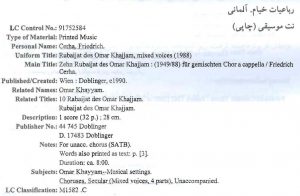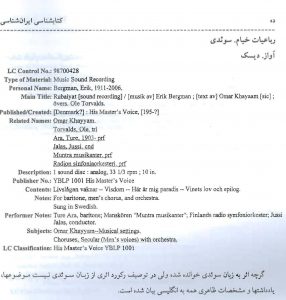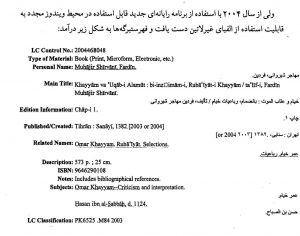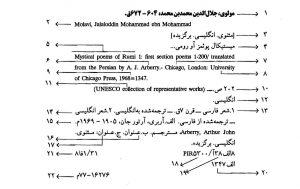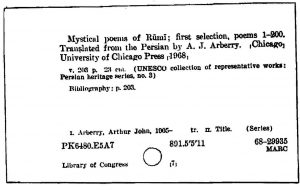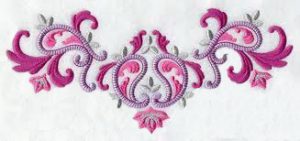
Kitābshināsī-i Īrānʹshināsī va Islāmʹshināsī bar mabnā-yi majmūʻah-ʼi Kitābkhānah-i Millī Sulṭānī, Shahdah,Sulṭānī, Pūrī, Fānī, Kāmrān. Publication: تهران : سازمان اسناد و كتابخانه ملى جمهورى اسلامى ايران، <2007> Edition: چاپ 1. Tehrān : Sāzmān-i Asnād va Kitābkhānah-i Millī-i Jumhūrī-i Islāmī-i Īrān, Persian, OCLC: 317825414
This bibliography of Iran/Islamic studies is presented in two volumes and the time period covers 1613-present. It includes books that have been written in languages other than Persian and Arabic by non Iranian authors. Also translations from Persian and Arabic by Iranian authors published in the 14th century have been eliminated.
List of books sorted by language are as follows:
- English: 7882 Titles
- Russian: 3027
- French: 2279
- German: 770
- Other: 20
Total 13,978
The Center for Library services (Tehran Book processing Center) was established in 1983 in the National Library of Iran. Their primary task was to catalog the Islamic studies collection of the National Library based on international standard. Holdings are divided into two sections, Persian-Arabic, which has always been cataloged in Persian, and other languages in English.
Transliteration from languages such as Persian, Arabic, Cyrillic, Swahili,…etc, facilitates a better access to a wide range of resources for researchers at the Library of Congress, also, cataloging all original and translations belonging to one author under one name in English, allows the patron to start the search with one single name in English such as Omar Khayyam, and find his entire literary work in many different languages. In the advent of electronic database, the patron types Omar Khayyam and is able to find a 300 collection of Khayyam’s works and not only poems in all languages but also in many different formats such as: CD, music, tape, etc.
Why the bibliography (cataloging) should be in Persian language?
Providing easy access to information is one of the main goals of every library and information center. Therefore, national libraries around the world, in addition to the Library of Congress, catalog their collection in their national language, regardless of the original language. Hence, the question is why shouldn’t we follow that pattern and catalog non-Persian holdings into the Persian language.
The reason Library of Congress couldn’t apply vernacular alphabets in its database for nearly two decades was that they had no choice but to apply MARC (Machine Readable Cataloging) in DOS operating system, when they began using computers to maintain their database. The entries were in English but the content remained in the original language. In 2004 a new program enabled the system to complete the entries with the information in the original language and script as well as its transliteration in the English language.
The idea of Persian language cataloging was initially proposed to the Pahlavi National Library in 1977 in the form of preliminary draft of recommendations to launch the Tehran Book Processing Center. However, it was also stated that certain preparations need to be in place before this idea can take shape, such as creating a transliteration table from various languages to Persian language. Also it was suggested that until such time, non-book items be cataloged in Persian alphabet and script, but LC style should be followed for all printed materials for the time being. Further, library information science was going through fundamental changes in Iran during the 60’s and the 70’s, so time was likely to be right for such radical changes in the arrangement of this collection. Later as the recommended developments were made such as; author’s Mark tables in Iran/ Islamic studies, creating Persian subject headings, translation of Anglo-American Bibliographic Description, and also
ISBD(M)-International Standard Bibliographic Description Monographs for Persian and Arabic, along with a lot of other helpful resources, the effort to catalog Latin alphabet text into Persian got finally started. The only problem at the beginning of this project was lack of Library Science majors with cataloging skills and knowledge of English, French, Russian and German. However, we were able to start the work on the French collection in 1996, English and Russian collection in 1997, and also German in the year 2000.
Comparison between Persian and Latin cataloging
The disparity between Iran/Islamic studies cataloging in Persian, and the LC collection is not just the translation from one language to the other, but is the nuts and bolts of how Iran National Library has integrated cultural and language identity into Dewey and LC classification system. Regardless of the original text, this initiative has been extended to all areas linked to Iran such as, literature, history, geography, theology, philosophy, music and arts. Same pattern has been applied to subject heading entries, it means that subjects have been modified according to the content. Also, same revision/editing is made for ISBD (International Standard Bibliographic Description), based on Persian language and cultural characteristics in the Iranian National Library. Therefore, current bibliography of Iran/Islamic studies has benefitted from all the mentioned modifications, and this process only started when the necessary ground work had been laid.
Moreover, nearly all books in the present bibliography can be found in the Library of Congress collection and database as well as other major western libraries, since LC cataloging has a reputation for impeccable accuracy, often times we use that as our guide for comparison, however, the end result as mentioned before, represents certain differences.
Search by author
Names are usually different from LC style. For example, you see Omar Khayyam in the LC database/card catalogs, but in this bibliography you see; Khayyam, Omar ebn Ebrahim, 422-517(Islamic calendar).
Corporate headings
When publishing is carried out by an institution or organization the title is translated into Persian not transliterated. As such, US Department of State is translated according to what It’s called in the Persian language which is, US Ministry of Foreign Affairs, although, the title in the original language is always available next to the translation. Such translations are based on a published translation of the list of foreign organizations that are kept in the National Library.
Search by subject
In most cases according to LC classification, there is no indication of the subject, such as, poetry, novel, play, etc, or categorizes it among a wide range of subjects. This is especially applicable when the original work is in vernacular languages (figures 1-3). However, the revised Persian version can be seen in the figure 4. Therefore, we have facilitated search by subject in special cases through the creation of specific subject headings (look under Khyyam in the present bibliography). In addition, we have included new subjects to the collection classified by LC for Iranian scholars, even if there is only a brief chapter about Iran. Subject headings are all in Persian language and extracted from “Farsi Subject Headings”, published by Iran National Library, 1381/2002.
Classification
The complete collection of the National Library has been classified according to Dewey Decimal and Library of Congress style. Although, as mentioned earlier, National Library holdings have gone through additional classification in order to meet the Persian language and cultural requirements (see figure 5). In cases such as applied or pure science, economy…etc, LC and Dewy classification are not altered. Catalogers have two different classification methods at their disposal, to choose which fits their requirements the best.
Author Mark
Author is a crucial factor for both Dewey and LC classification. As there might be several copies of books under the same subject, therefore, special codes are applied to distinguish between them based on author, as such; shelving these similar groups becomes easier as well as retrieving them. Previous to adapting Persian codes, books were shelved according to English language alphabet.
Indexing
- Subject index 15,593 entries
- Title index in English 7,467 entries
- Title index in Russian 3,027 entries
- Title index in French 2,157 entries
- Title index in German 753 entries
- Title index in other languages 20 entries
- Name index in French, English,
- German and other languages 8430 entries
Total 42180 entries

